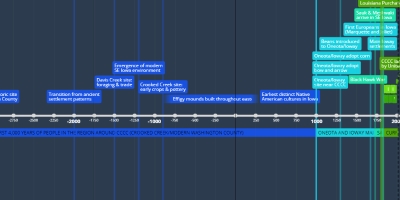ONEOTA AND IOWAY MAIN NATIVE AMERICAN GROUP LIVING IN SOUTHEAST IOWA (jan 2, 1000 – jan 1, 1730)
Description:
Ioway oral history indicates that the clans were once separate groups living throughout Iowa, and then came together to become the Hungeh nation, who many people from the Ioway, Oto, Missouri, and Winnebago tribes understand to be their ancestors. In archaeology, the Ioway ancestors are termed the Oneota, whose distinguishable culture researchers generally date back to 1000 c.e. Lance Michael Foster, a historian who has written extensively on the Native American groups of Iowa, finds the archaeological findings to be useful information, but adds: “As an Ioway, my position is that we have always been here, in one form or another…”Whatever the case may be, the Ioway people and their ancestors are the group who came to know most intimately the forests, prairies, rivers, and hills of the corner of Iowa where Crooked Creek Christian Camp now sits. While Sauk and Meskwaki communities and American settler communities moved to eastern Iowa from distant homes, Oneota and Ioway culture was in fact born here. In his article The Ioway and the Landscape of Southeast Iowa, Foster says “The Ioway language reveals much about this landscape.” There are a variety of terms which refer to specific ways of traveling through the tall-grass prairies historically characteristic of Iowa, something they did much of on their annual buffalo hunts. There are also many words which describe their ancestral “world of water,” and indeed, perhaps the clearest aspect of their lifestyle that can be considered distinctly “Eastern Iowan” was their relationship with the eastern Iowa waterways. Upon relocation to their reservation in Nebraska and Kansas at the beginning of the 19th century, they chose to settle in an area surrounded by prairie and timber, and made their homes upon the river bluffs where many Ioway still live today. For many hundreds of years before that, the Ioway and their ancestors lived along the rivers and creeks in eastern Iowa instead. The river closest to Crooked Creek is still known by a name passed down to our English-speaking community from the Ioway via the Sauk and Meskwaki: The Ioway’s Mungka Nyi was translated by the Sauk and Meskwaki to the Chicaqua, and again by American settlers to the Skunk River. On this river—and along waterways all throughout eastern Iowa—the Ioway gathered reeds for their houses and basketry, sculpted pottery from clay made with crushed mussel shells, and grew corn on terraces above the flowing water.
Added to timeline:
Date:
jan 2, 1000
jan 1, 1730
~ 730 years
